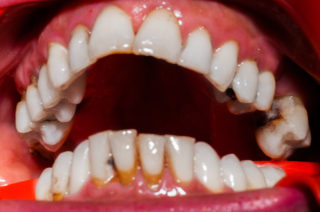What is gingivitis?

Gingivitis is a multifactorial disease, which results from a complex relationship between infectious agents and host factors. Gums are a very vulnerable area of the mouth that is subjected to various risks and dangers.
Gingivitis is the first stage of gum disease. The usual colour of the gum is pale pink. Gingivitis will cause the gums to acquire a reddish colour. They can swell or be excessively smooth and shiny. Light or severe blood loss may occur while eating or during oral hygiene. Bacteria will release aggressive substances (toxins) and the body will try to protect itself. These bacteria will cause an inflammation.
Gingivitis is mainly caused by plaque build-up close to the gums. This build-up of bacteria, known as plaque or biofilm, is a result of bits of food accumulating between the teeth over time. If the plaque is not removed, it will turn into a hard substance called tartar. These bacteria attack the periodontium (alveolar bone, periodontium ligament, and cementum), which is the tissue that supports the teeth.
Gingivitis is the first stage of periodontitis. When it occurs, it is not painful. However, if this disease starts to spread, it will severely affect the teeth and cause discomfort.
Stages of Gingivitis:
Initial stage: Slight bleeding may occur while brushing. The gums will be slightly reddish. It is hard to detect the disease at this stage.
Intermediate stage: During this stage, the first wound appears. Gums are a little more reddish, there is more bleeding while brushing, and sensitivity increases.
Final stage: The wound will become severe. Bleeding may be more severe while brushing. The epithelium widens, which is the space between the gum and teeth.
What are the symptoms ?
Gums will become reddish and the person experiences pain and sensitivity to heat or cold. Bad breath can also appear. Receding gums may occur and, for this reason, the teeth will look bigger. Sometimes, pus pockets will appear close to the gum.
Causes of Gingivitis
Gingivitis is mainly caused by plaque build-up on the gum line. This plaque is known as tartar and can be associated with hormonal changes. Teenagers are susceptible to this inflammation as they go through a period of intense hormonal activity. Women, particularly during their menstrual period, may have gingival hyperplasia, which consists of enlargement and swelling of the gums.
Pregnant women are considered a risk group. The inflammation in these cases is called pregnancy gingivitis, which may develop into a pus pocket (periodontal pocket).
There is a greater incidence in people who have physical disabilities, misaligned teeth (crowding teeth), or misuse their braces. These characteristics cause difficulties during oral hygiene.
Other types are related to systemic diseases, such as diabetes, leukaemia, and AIDS. These diseases cause healing difficulties and low immunity, which makes the gingivitis more aggressive.
Smokers are among the most acutely prone to gingivitis. Smokers produce less saliva, leading to a low production of antibodies. Therefore, the tobacco smoke changes body response to bacteria. The body will become weak with the tobacco smoke and will not be able to defend itself.
Where can gingivitis occur?
Gingivitis may be localised in one tooth or be widespread, affecting numerous teeth. It can affect only the papillae (papillary), extend to the marginal gum (marginal), or even extend to the attached gum (diffuse gingivitis).
What are the complications ?
The gums will bleed. Can also occur due to difficulties in diagnosing its symptoms. If it is not correctly diagnosed and treated, in extreme cases, gingivitis may lead to dental loss, or in other words, the extraction is inevitable. The infection spreads and destroys ligaments of the teeth and the surrounding tissues. The gums will progressively detach and the tooth will fall out. In its acute stage, gingivitis can become periodontitis.
What is the treatment for gingivitis?
- Regular dental appointments every six months or once a year will prevent the disease to evolve to a stage where irreversible damage may occur.
- Scaling and Root Planing will remove bacterial plaque.
- Oral hygiene is extremely important . Good oral hygiene prevents gum diseases.
- There are toothpastes to prevent gum bleeding. Brush your teeth several times a day and include every mouth region, such as the tongue and palate (roof of the mouth).
- You should use mouthwash to support your oral hygiene. Mouthwash eliminates bacteria that can remain between the teeth, even after proper brushing.
Vita Center Medical Reference- Reviewed by VitaCentre Dental Clinic Staff on July 29, 2022

